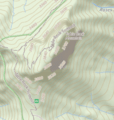Brown Mountain Lights facts for kids
The Brown Mountain Lights are mysterious glowing lights. People have reported seeing them near Brown Mountain in North Carolina. You can often spot them from places like the Blue Ridge Parkway. Good viewing spots include overlooks at mile posts 310 and 301. You can also see them from the Brown Mountain Overlook along North Carolina Highway 181. Other great places are the top of Table Rock and Wiseman's View. Both are in the Linville Gorge Wilderness.
Contents
The Mystery Begins: History of the Lights
The first stories about these lights appeared around 1912. This was shortly after the book Master of the World by Jules Verne was published in English. In Verne's novel, a scientist builds an airship inside Table Rock. His work causes strange lights to appear on the mountain.
Early Sightings and Stories
The area around Linville Gorge started getting electricity in the late 1800s and early 1900s. This might be how the legend of the Brown Mountain Lights began. Jules Verne's book may have also helped the stories spread. Before 1900, many travel books mentioned mysterious events in the region. But none of them talked about unexplained lights.
Many local people didn't even know about strange lights until 1910 or later. One resident, Joseph Loven, said he first saw lights in 1897. But he didn't think much of them. No one else talked about them until his neighbor, Rev. C. E. Gregory, started telling people around 1910.
An early newspaper report from September 24, 1913, described the lights. The Charlotte Daily Observer said "mysterious lights" appeared every night. They were red and showed up "punctually" at 7:30 PM and again at 10 PM. This information came from Anderson Loven, a trusted local.
Government Investigations Start
Just like in Verne's novel, locals asked their government for help. In 1913, D.B. Sterrett from the United States Geological Survey was sent to investigate. He quickly found that headlights from trains were visible from Loven's Hotel. He checked train schedules and believed these were the lights people saw.
In July 1916, a big flood stopped trains around Brown Mountain for weeks. This made some people doubt Sterrett's findings. George Anderson Loven, whose hotel was busy with visitors, told a newspaper the light was still seen nightly. It's not clear if he meant one specific light or many different lights. It's also possible he considered any nighttime light from his hotel mysterious. Train headlights were not the only possible source. Car headlights were also likely contributors.
What Do Scientists Say?
Reports of strange lights continued. So, the US Geological Survey started a more formal study in 1922. They concluded that witnesses were seeing car lights, train lights, fires, or regular stationary lights.
Modern Research and Cameras
However, a marker on the Blue Ridge Parkway says something interesting. A huge flood hit the area right after the 1922 study. All electricity was lost, and trains stopped running. Several car bridges were also washed out. But the Brown Mountain lights supposedly kept appearing.
Appalachian State University set up two special cameras. These cameras were on rooftops overlooking Brown Mountain and Linville Gorge. By 2014, these cameras had recorded 6,300 hours of video. They did not record any lights that couldn't be explained.
Images for kids
-
Mansfield used a special tool to map the Brown Mountain light sources. From high viewpoints, it was easy to see distant electric lights. These included train and car headlights near towns. Most viewing lines passed over Brown Mountain. This made people think the mountain was connected to the lights.




